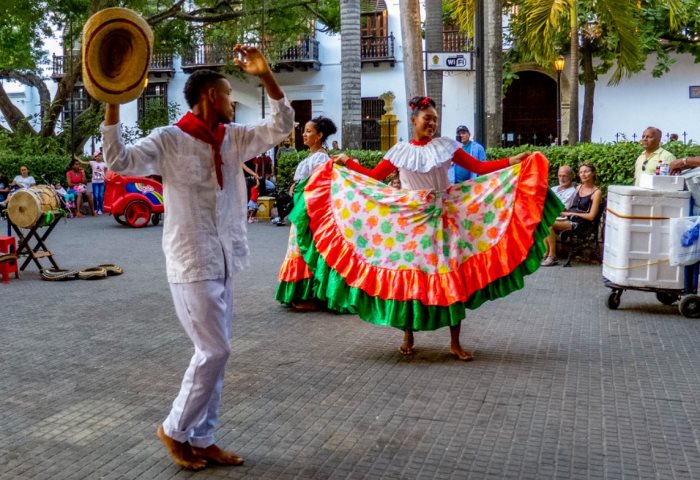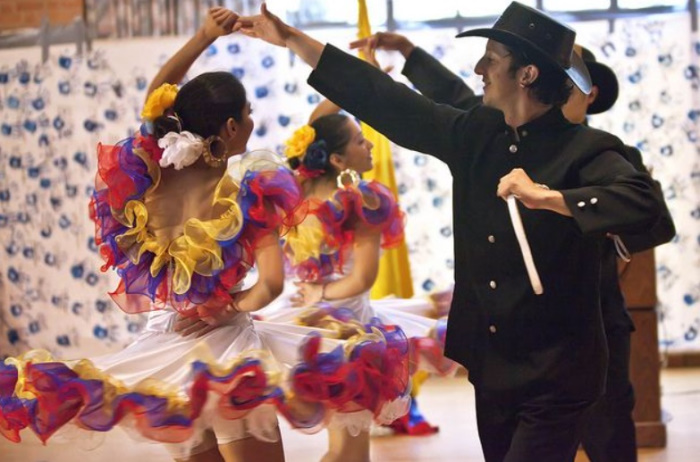The number of traditional Colombian dances is large enough to surprise anyone. No matter where you head in this country, you will be surrounded by music.
Now, let’s see what the people in Colombia enjoy dancing to and keep as part of their lives!
Table of Contents
Traditional Colombian Dances As Sources Of Their Inspiration
Bambuco

Bambuco is not only a traditional dance but it also has an indigenous origin. Coming from the Ardean region, Bambuco holds a beautiful meaning about love and a deep connection to the people.
The main instrument in Bambuco music is the guitar, evidence of the Spanish influence infused within it.
There are usually two or three musicians accompanying and singing, plus a few others playing with strings and percussions.
While many traditional dances are a collective activity, Bambuco is first and foremost for couples.
Women have long white dresses with radiant colors and flower patterns while men portray a very gentlemanly look with white blouses and black trousers.
Furthermore, the pair will share a bandana as a token of “love chase” through the four phases of the performance: invite, flirt, pursue, and unite.
If you can’t bring the whole outfit with you as a souvenir, the signature red bandana would suffice!
Unfortunately, the popularity of Bambuco is decreasing because it is more choosey with its audience compared to modern songs and dances.
If you want to thoroughly enjoy it, your best bets are little towns in the region.
Check more: 8 Traditional Turkish Dances
Bullerengue
As Bullerengue came from the Atlantic Coast, there is nothing surprising that it carries the spirit of the community and the enriched tradition of the Afro–Columbian folks.
Before the choreograph was born, it was a musical genre indicating freedom.
Bullerengue has a name for its performers, “Cataoras”. They are usually powerful and elder women with viscerally stronger voices to match the African percussion and convey various nuances of emotions.
In combination with the music, they will execute dance moves symbolizing the role of a woman in society.
The movements usually balance joy and sorrow, relaxation and hardship, and all of these aspects are depicted with depth and humor.
For people who want to explore and learn Bullerengue, there are workshops with experienced “cantaoras” showing you how to empower yourself through singing and dancing while creating a cultural connection with Colombia’s Caribbean Coast.
Cumbia – Colombia’s National Dance
You might have seen the name Cumbia while browsing Latin–American music genres. When Spanish colonizers, Afro-born folks, and indigenous people interacted culturally, the Colombian Cumbia was manifested.
The band for Cumbia performances includes three flutes and three drums, though additional brass instruments, guitar, and piano. No matter what comes into play, the meter is either 2/2 or 2/4.
It is probably the traditional dance of Colombia with the most recognizable costume.
For the ladies, off-shoulder shirts with white & red checkered and long, flowy skirts are the way to go. Meanwhile, the men wear white clothes and a sombrero vueltiao on top.
For a modern performance of Cumbia, it’s important to know whether you are the leader or the follower.
Although the couple will execute similar dance moves, they need to always be on opposite sides and mirror each other.
Don’t be shy to start right away if you are interested in Colombian culture, for Cumbia is very friendly for beginners.
Read more: 50+ Traditional Indian Folk Dances
Champeta

From a genre inspired by the Africans, Champeta has gone a long way to be the most popular dance in Colombia ever since the 1980s. To this day, it is still appreciated and favored by young people.
The word “champeta” refers to a short and slightly curved knife. The Caribbean region uses it both as a kitchen tool and a weapon. And, it is a reminder of maltreatment and slavery now.
In Champeta, the rhythm has a dominant role over the harmony and the melody.
Therefore, the music sounds extremely simple despite the strength and the elasticity coming from a mixture of percussion, bass, synthesizer, and vocal.
Although the Champeta music used to be labeled as a thug trademark, the dance associated with it is on the sensual side.
Performers can do a solo or a duet, depending on the situation, though the complex footwork remains the same either way.
Joropo
Joropo is a style of music closely related to the Fandango and later an accompanying dance routine.
However, instead of Colombia, it originated from Venezuela and adopted influences from other cultures before taking over Colombia by storm.
Inspired by the lifestyle and the nature of Llanos Orientales, Joropo music consists of maracas, harps, and loud vocals with high notes. It is challenging for sure, though the energy it conveys is amazing.
As a traditional dance, Joropo has a specific set of outfits for the performers.
The gentlemen will adorn long pants, jackets, and optional cowboy hats. It has a nice contrast with the women’s lovely braided hair and feminine dresses.
In synchronization with the music, the dance is strong and quick-paced. Both leaders and followers have to possess decent footwork and stamina while holding each other close and exuding hints of intimacy.
If not Venezuela and Colombia, it is unfortunately difficult for you to find a studio or class teaching Joropo techniques. But the videos on the internet might give you an easy beginning, should you want to get sweaty!
Mapalé
The name is derived from “Cathorops mapale”, a fish species of the Caribbean region.
Therefore, it is quite understandable that the dance imitates a fish being caught and struggling to survive. Other sea creatures also appear in the performance.
Both men and women can participate in the performance.
Men will wear long trousers and women will put on short dresses with elaborate details on their hips. They can go barefoot or adorn flat shoes, yet the headgear with turbans is a must.
The performers will form two lines with the males and the females confronting each other.
They execute to-and-fro footwear at a quick pace and continuously clap their hands while the men court their partners and the women respond to the advances.
The wide range of movements includes jumping, shoulder rolling, hip shaking, and more. With the drum beats accompanying, this dance has an erotic and exciting vibe.
As you might have guessed already, the Mapalé dance needs to express the strength and diligence of African people.
Through hardships, they still gathered as a community and preserved their culture. And the Mapalé dance represents the resistance back then.
Porro
Porro is a small branch of the Cumbia music. However, compared to Cumbia, Porro is much faster and livelier.
The Porro band often contains brass instruments or follows the orchestra style. It is separated into two parts:
- Palitiao: A bombo drum comes in use and creates sounds resembling cowbells.
- Tapao: Closely tied to Cartagena’s savannas, also named “sabanero”.
Before the 1950s, Porro was hidden behind closed doors by people of the working class. It was not until three decades later did it became more socially accepted and attracted more people.
After adapting movements of tango and salsa, Porro shifted into the ballroom dance scene and reached more people.
Some schools in Colombia even include this dance in their education program. The students can dance to Porro in pairs and execute complex moves.
Salsa
Who would have thought Colombia had their version of Salsa?
Nevertheless, the Colombian Salsa is only popular in the South American country. It retains the challenging footwork and adopts tricky lifts for more excitement in the performance.
This Salsa variation originated from Cali City, hence you might sometimes hear people call it “Salsa Caleña” (Cali-style Salsa).
Due to the popularity as well as the difficulty level of the dance, Cali is recognized as the Capital of Salsa with numerous competitions.
When doing Colombian Salsa, the dancers often hold their upper body firm and still while their legs execute rapid movements in a circular pattern.
In a way, it resembles the Cumbia dance but increases the pace tremendously.
Of course, the best place for you to approach and learn Colombian Salsa is the country itself.
If you reside in another country, the chance is extremely thin, though more and more Salsa instructors have traveled and brought the dance abroad.
Other Traditional Colombian Dances
- Abozao
What is more intriguing than a folk dance with erotic feels? This African-born dance is a mixture of suggestive gestures and impressive footwork.
It is typically performed in a group, with the men and the women forming two lines.
The males will lead the dance and sometimes surround the females, yet they don’t hold onto each other at all.
- Betsknaté
The gathering of the indigenous communities in the Alto Putumayo region was survived by this dance.
Leading the parade is the greater matachin wearing a signature red mask and bringing a bell with them.
The performance is always part of the local festival and hence full of vibrant colors.
- Contredanse
Derived from a dance called Crydance – which can be translated to “field dance” – this quadrille was mostly presented in the festivals of the elites before being passed to numerous social classes.
It has an elegant touch to it, though the duration of 60 minutes with no break is enough of a challenge for every dancer.
- Corridor
As the European Waltz spread its influence across the country, the derivative of it also became remarkably more well-known. And we now refer to it as the Corridor dance.
There are two types of Corridor dance, the partying version is for occasions like weddings and gatherings, while serenades involve the slow version instead.
- Currulao and Bunde
Among all Afro–Colombian dances, Currulao and Bunde are the most important because they have the traits left by the colonizer’s slaves.
Currulao is a dance for couples, wherein the male courts the female and begins a love story. Meanwhile, Bunde has a more religious vibe and appears mostly in celebrations.
- Galley
Colombian festivals usually feature the Galley dance, hence you can already tell it is packed with good vibes.
Some people would say the dance looks like a little chase, wherein the male dancer runs after his female partner.
Using a handkerchief as props, he will rotate and revolve around it, making the performance more fun to watch.
- Guabina
Guabina is a minor musical genre often seen at Christmas parties and farmers’ gatherings.
The dance associated with it was, unfortunately, disapproved by the Church at the start of the 19th century, for the dance moves looked too intimate.
- Jota Chocana and Caderona
Both of them have an origin combined with African and European characteristics. They are executed in pairs like their Spanish versions but at a much faster pace.
- Vallenato
As an Intangible Cultural Heritage of Humanity, this dance has a significant role in Colombian culture.
It is mainly accompanied by the accordion and percussion instruments, bagpipes and strings are optional.
A pair of dancers will perform the Vallenato at their own pace. The intimacy level is up to them, so they can dance separately or closely.
- Whirlwind
A list of traditional dances wouldn’t be complete without a dance of the farmers. Performed at weddings, pilgrimages, and parties, the Whirlwind dance is rather versatile with its expressions.
The performers are put in pairs and take turns to chase their partners. There are no complicated movements involved, thus even children can take part in the fun.
Closing Words
A talk about traditional Colombian dances can go on endlessly. The country is extremely rich when it comes to arts, including music and choreography.
Each of them has a story behind it, though they all contribute to the diversity and variety of the culture!


